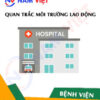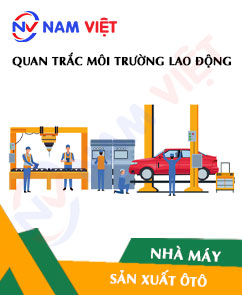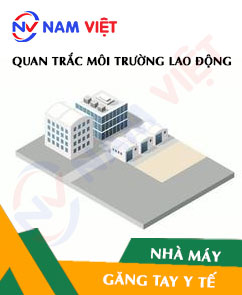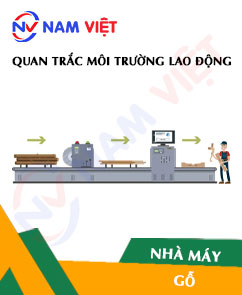Occupational environment monitoring of a mechanical manufacturing factory
99,000 ₫
Note: The above price is calculated for one sample, and the price may fluctuate depending on the area of the environment to be monitored and market movements. For more accurate pricing support, please refer to the price list or contact our consulting staff directly.
Monitoring the environment of a mechanical manufacturing factory is a session of collecting, analyzing, and evaluating factors at the workplace that may harm workers health.
Table of Contents
Toggle1. Overview of Mechanical Factories
a. What is a Mechanical Factory?
A mechanical factory is a production facility where mechanical components and products are manufactured, processed, and assembled. Mechanical factories typically have workshops, specialized equipment, and machinery to carry out production and processing of mechanical parts.
Mechanical factories can produce a wide range of products, from small components such as screws and bolts to large parts like machine frames, gears, shafts, bearings, and other complex mechanical products.
In a mechanical factory, the production process usually includes mechanical processing, welding, grinding, casting, metal fabrication, coating, and assembly. The technology and production process in a mechanical factory often depend on the specific product being manufactured.

b. Production Stages in a Mechanical Factory
Production stages in a mechanical factory may include:
- Design and Research: This process involves researching, analyzing requirements, and designing the mechanical product. Engineers and designers use CAD/CAM software to create technical drawings and 3D simulations of the product.
- Mechanical Processing: This involves processing mechanical parts from metal sheets or steel bars through cutting, milling, turning, drilling, planing, CNC machining, and other methods. The mechanical processing technology may vary depending on the product type and materials used.
- Welding: Welding is used to join mechanical parts by applying high heat to fuse them together. Methods include electric welding, MIG/MAG welding, TIG welding, spot welding, and laser welding.
- Casting and Metal Pressing: This process involves casting and pressing metal parts by melting metal into molds or applying pressure to shape materials.
- Coating and Finishing: These steps include coating the surface of mechanical parts to protect them from corrosion and enhance aesthetics. Coating processes include cleaning, priming, main coating, and finishing.
- Assembly: This is the process of assembling the manufactured mechanical parts into a complete product. Parts and components are assembled and inspected to ensure quality and functionality.
The production stages in a mechanical factory may vary depending on the product type and the specific manufacturing process of each factory.

c. Machinery Used in Mechanical Factories
Mechanical factories use a variety of machinery to perform production and mechanical processing stages. Below are some commonly used machines in mechanical factories:
- Lathe: Used for machining round parts by removing excess material from the workpiece surface. Lathes can process complex parts and create curves and grooves on surfaces.
- Milling Machine: Used to process parts by removing excess material using a rotating milling cutter. Milling machines can produce complex parts with diverse shapes and sizes.
- CNC Lathe: A Computer Numerical Control (CNC) lathe is operated by computer and uses numerical programs to perform precise and automated machining operations.
- CNC Milling Machine: A CNC milling machine is computer-controlled, allowing precise and automated machining of complex parts.
- Multi-Function CNC Machine: These machines can perform multiple processes such as turning, milling, drilling, and grinding on a single machine, saving space and increasing production efficiency.
- Welding Machines: Used to join metal parts by applying high heat. Types include electric welding, TIG welding (argon), MIG/MAG welding (CO2 or mixed gas), and spot welding.
- Metal Press: Used to press metal parts into desired shapes by applying force to the material.

d. Occupational Diseases in Mechanical Factory Workers
Workers in mechanical factories may face several occupational diseases due to environmental factors and their job tasks. Common occupational diseases in the mechanical industry include:
- Respiratory Diseases: Workers may be affected by metal dust, chemical fumes, welding smoke, or grinding dust, leading to pneumonia, asthma, and other respiratory problems.
- Skin Diseases: Contact with chemicals, oils, or cleaning solutions can cause skin irritation, dermatitis, eczema, or psoriasis.
- Noise-Related Diseases: Machinery and processing in mechanical factories can produce high noise levels, causing hearing loss and auditory impairment.
- Spinal and Musculoskeletal Disorders: Jobs in the mechanical industry often require lifting heavy objects, bending, or repetitive motions, leading to spinal issues, vertebral degeneration, and other musculoskeletal problems.
- Exposure to Toxic Substances: Some jobs involve exposure to toxic substances like lead, asbestos, cyanide, or other chemical compounds. Long-term exposure may cause serious health issues, including liver, kidney diseases, and cancer.
- Injury-Related Diseases: Workers may suffer injuries from workplace accidents such as cuts, impact wounds, crushing, burns, or contusions.

e. Products Manufactured in Mechanical Factories
Mechanical factories produce various products depending on the field and specific use. Common products include:
- Machine Parts: Factories produce machine parts such as shafts, bearings, gears, pulleys, pistons, valves, connectors, and other components.
- Electronic Equipment: Mechanical factories may produce electronic components such as printed circuit boards, boards, connectors, pins, and electronic control units.
- Transport Equipment: Products may include transport parts and equipment like wheels, gear shafts, transmission systems, conveyor systems, and other machinery mechanisms.
- Piping and Water Supply Systems: Factories may produce piping equipment and components like pipe connectors, valves, gate valves, globe valves, and other parts for water supply and piping systems.
- Industrial Machinery: Products may include industrial machines such as compressors, pumps, chillers, lifting machines, winches, and other industrial equipment.
- Household Products: Some factories produce household products like gas stoves, air purifiers, fans, and other household items.
- Automotive Parts and Equipment: Factories may produce automotive components such as brake discs, oil filters, brake systems, fuel tanks, and other car parts.

2. Overview of Occupational Environment Monitoring Services
a. What is Mechanical Factory Occupational Environment Monitoring?
Occupational environment monitoring (or occupational environment measurement) in mechanical factories is the activity of collecting, evaluating, and analyzing measurement indicators of workplace environmental factors in mechanical factories to take timely measures, reduce environmental harm to workers’ health, and prevent occupational diseases. Occupational environment monitoring is mandatory for mechanical factories.
Occupational environment monitoring plays a crucial role in protecting, maintaining, and enhancing worker health because workers are the main resource of a business and directly generate profit. Workers who are frequently exposed to risk factors and occupational hazards exceeding permissible limits may suffer health effects and develop occupational diseases.
REGISTER FOR OCCUPATIONAL ENVIRONMENT MONITORING SERVICE
b. Nam Viet Occupational Environment Monitoring Program
Nam Viet’s occupational environment monitoring program is researched by monitoring engineers specializing in occupational safety and environmental protection. Aiming to ensure workers’ health and safety, the program uses modern measurement methods to monitor air quality, water, microclimate, physical factors, dust, and more in the workplace. This program is crucial for maintaining a safe working environment and protecting workers’ health.
Additionally, Nam Viet’s program plays an important role in researching and developing solutions to improve occupational environment quality. With a dedicated and professional team of monitoring experts, Nam Viet’s exclusive monitoring program is becoming a breakthrough in occupational safety and environmental management in Vietnam.

c. Standardization in Occupational Environment Measurement Procedures
Standardization in Nam Viet’s occupational environment measurement procedures is vital for ensuring measurement accuracy and reliability. To ensure precise and reliable results, the program applies recognized standards and standardized procedures from the Ho Chi Minh City Department of Health. This ensures collected data can be reliably used in evaluating workplace environment and making decisions to improve occupational health protection.
These standardized procedures also ensure that measurements are conducted by highly qualified monitoring specialists with years of experience, allowing managers and experts to trust the results from Nam Viet and make accurate, valuable decisions to protect workers’ health and the environment.
By applying standardization in occupational environment measurement, Nam Viet demonstrates its commitment to a safe working environment and worker health, contributing positively to the development and improvement of occupational safety and environmental management in Vietnam.
d. Mechanical Factory Monitoring Report
Occupational environment monitoring results are compiled according to Form No. 04, Appendix III issued with Decree 44/2016/ND-CP and prepared in two copies: one sent to the contracted workplace and one retained by the monitoring organization.
Monitoring records are retained indefinitely according to legal regulations.

e. Frequency of Occupational Environment Monitoring as Required by Law
According to Clause 2 of Article 18, Law on Occupational Safety and Hygiene 84/2015/QH13, employers must organize occupational environment monitoring to evaluate harmful factors at least once per year.
f. Deadline for Submitting Occupational Environment Monitoring Reports
The deadline for submitting reports is before December 31 each year. Enterprises in production facilities must submit occupational environment monitoring reports to the local Department of Health where the business is headquartered and where workers are employed.
When there are changes in technology, production processes, or upgrades that may introduce new hazardous factors, enterprises must update occupational hygiene records regarding harmful factors that require monitoring.
g. Penalties for Violations of Occupational Environment Monitoring by Employers
According to Article 27 of Decree No. 12/2022/ND-CP dated January 17, 2022, regulating administrative penalties in labor, social insurance, and Vietnamese workers working abroad under contracts:
- Clause 2: Fines from 2,000,000 – 5,000,000 VND for employers who fail to publicly announce monitoring results and hazard assessments to workers at the monitored site and evaluation locations immediately after results are available.
- Clause 3: Fines from 20,000,000 – 40,000,000 VND for employers who fail to conduct occupational environment monitoring to control health hazards as required by law.
- Clause 4: Fines from 40,000,000 – 60,000,000 VND for employers who collude with monitoring organizations to commit fraud in occupational environment monitoring activities but do not reach the level of criminal liability.
3. Harmful Environmental Factors for Workers in Mechanical Factories
Workers in mechanical factories may be exposed to various harmful environmental factors that can affect their health. Here are some potential environmental hazards in mechanical factories:
- Dust and particles: Metal machining and grinding processes can generate metal dust and particles. Prolonged exposure to metal dust may cause pneumonia, rhinitis, pharyngitis, and other respiratory problems.
- Fumes and toxic gases: Using chemicals such as solvents, gasoline, lubricants, detergents, and cleaning agents during mechanical manufacturing can produce fumes and toxic gases, including volatile organic compounds, carbon monoxide, nitrogen oxides, and sulfur dioxide. Exposure to these substances can cause health problems ranging from mild fatigue and headaches to severe issues like nervous system damage, hepatitis, and respiratory disorders.
- Noise: Machinery and mechanical processes produce high levels of noise. Continuous exposure to high-intensity noise can damage hearing, leading to hearing loss and ear-related problems.
- Vibration: Machinery in mechanical factories generates vibrations. Continuous exposure to vibrations can harm joints, muscles, and the nervous system, causing health issues such as back pain, neck pain, and vibration-related disorders.
- Temperature and humidity: Working environments in mechanical factories may have high or low temperatures and unstable humidity. Improper temperature and humidity conditions can cause discomfort, affect health, and increase the risk of workplace accidents.
REGISTER FOR OCCUPATIONAL ENVIRONMENT MONITORING SERVICE
4. Measures to Improve Working Conditions in Mechanical Factories
Improving working conditions in mechanical factories is crucial to protect workers’ health and ensure safety. The following measures can be applied:
- Dust and particle management: Ensure an effective dust extraction system and measures to limit dust during metal machining. Use air filtration systems and dust extraction devices to reduce exposure to metal dust and particles.
- Toxic chemical management: Implement safety measures to control and reduce exposure to hazardous chemicals. Ensure safe use of cleaning agents, solvents, and additives, and provide personal protective equipment such as masks, gloves, and chemical-resistant clothing.
- Noise control: Apply noise control measures such as sound barriers, protective headphones, acoustic partitions, and technical measures to reduce noise to safe levels for workers.
- Vibration control: Apply vibration control measures, including using vibration-damping equipment, minimizing vibration from machinery and work processes, and providing training on using protective equipment like gloves and anti-vibration shoes.
- Temperature and humidity stabilization: Control temperature and humidity in the workplace using air conditioning systems and ventilation management to ensure a comfortable and safe working environment.
- Training and awareness: Provide training and raise awareness about occupational health and safety for workers.
- Periodically conduct occupational environment monitoring in factories, collect and analyze harmful factors affecting workers, and adjust measures to reduce risks and prevent occupational diseases.
5. Benefits of Regular Mechanical Factory Monitoring
An Toan Nam Viet provides businesses with excellent benefits when using occupational environment monitoring services according to Decree 44/2016/ND-CP on managing and controlling harmful factors in the workplace affecting workers.
- Businesses can proactively control harmful factors in workshops or factories.
- Receive recommendations to reduce harmful factors and improve workplace environment quality.
- Indirectly protect human resources, a key factor in business development.
- Reduce the impact of occupational diseases on workers’ health, lowering future treatment costs.
- Improve workers’ health, ensuring product quality and consistent output.
- Comply with labor safety regulations and avoid legal risks.
- Enhance reputation and professionalism, elevating the business’s brand.
Nam Viet’s occupational environment monitoring service is a solution to minimize the risks of occupational diseases, contributing to a healthy and high-quality working environment.

6. National Occupational Environment Monitoring Center
Nam Viet Occupational Environment Monitoring Center is a professional unit specializing in supervising and measuring workplace environmental quality throughout all provinces in Vietnam. With an experienced team of monitoring specialists, the center uses modern measurement equipment to ensure accuracy and reliability.
In addition to monitoring services, the center assists clients in planning, handling, and tracking occupational environment issues. Following the motto “customer-centered,” the center prioritizes client satisfaction, meets all needs, and provides the best solutions for businesses.
REGISTER FOR OCCUPATIONAL ENVIRONMENT MONITORING SERVICE
With investments in technology, equipment, and workforce, Nam Viet’s monitoring center has become one of the most reputable units in occupational environment monitoring in Ho Chi Minh City with the following objectives:
- We always value brand reputation and the quality of our services.
- We provide clients with the best and most suitable solutions possible.
- Alongside a team of experienced Masters and Engineers, we aim to protect the environment and benefit businesses.
- Working with Nam Viet Environmental Monitoring, companies receive professional service from experts and the best cost advantages.
The occupational environment monitoring process at Nam Viet includes the following steps:
- Before monitoring, all equipment is calibrated and compliant with legal regulations.
- Carry out the monitoring process fully and correctly as committed to the Department of Health.
- Accurately report monitoring results to employers.
- If results indicate unsafe conditions, Nam Viet provides corrective solutions, and the facility implements the following:
- Implement measures to improve working conditions, minimizing harmful factors and preventing occupational diseases.
- Organize health checkups to detect occupational and work-related diseases early for employees in unsafe positions.
- Provide material support to employees according to labor law regulations.

7. Pricing for Occupational Environment Monitoring
To help businesses carry out occupational environment monitoring professionally and effectively, Nam Viet provides clients with a detailed and reasonable price list for monitoring services.
- The price list provides detailed information about costs of monitoring services, including transportation, measurement, analysis, and reporting. Clients can trust the accuracy and reliability of the reports.
- We always offer competitive and reasonable prices and are ready to answer all inquiries quickly and professionally.
- With Nam Viet’s price list, clients can easily select service packages that suit their needs. We commit to delivering maximum satisfaction with professional service quality.
1 review for Occupational environment monitoring of a mechanical manufacturing factory
No comments yet












maituyet.cuong12
Good labor environment monitoring service!